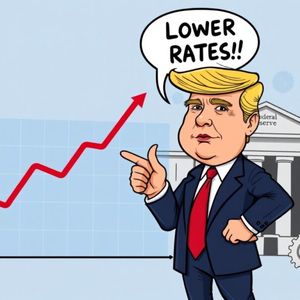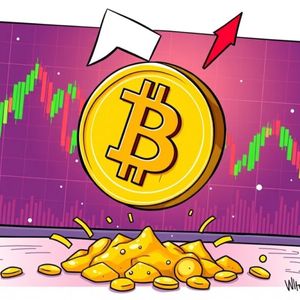Fed Rate Cut: Trump’s Urgent Call After Stellar Q2 GDP Boosts Economy
8 min read
BitcoinWorld Fed Rate Cut: Trump’s Urgent Call After Stellar Q2 GDP Boosts Economy In a move that sent ripples through financial markets and political circles alike, former U.S. President Donald Trump recently took to Truth Social, declaring the Q2 GDP report as ‘way better than expected.’ This robust economic performance immediately fueled his call for the U.S. Federal Reserve (Fed) to implement an immediate Fed rate cut . The news, initially reported by Walter Bloomberg on X, highlights a persistent tension between political desires for economic stimulation and the Fed’s mandate for price stability and maximum employment. For anyone tracking the pulse of the global economy, especially those with a keen eye on cryptocurrencies, understanding the implications of a potential Fed rate cut is crucial. What Sparked the Call for an Immediate Fed Rate Cut ? The catalyst for Trump’s bold statement was the surprisingly strong Q2 Gross Domestic Product (GDP) report. GDP, a key indicator of economic health, measures the total value of goods and services produced in a country. A ‘better than expected’ reading typically signals robust economic activity, often leading to optimism about future growth. Trump’s argument is straightforward: if the economy is already performing well, lower interest rates would provide an even greater boost, making borrowing cheaper for businesses and consumers, and theoretically accelerating job creation and investment. Strong Economic Data: The Q2 GDP figures likely surpassed analyst forecasts, indicating underlying economic strength despite ongoing global uncertainties. Trump’s Consistent Stance: Throughout his presidency and beyond, Donald Trump has been a vocal critic of the Fed’s interest rate policies, consistently advocating for lower rates to stimulate growth and reduce the national debt’s servicing costs. Public Platform: Using Truth Social, his preferred communication channel, allowed him to directly address his base and the broader public, amplifying his message for an immediate Fed rate cut . This public pressure on the independent central bank is not new, but it underscores the political weight often placed on monetary policy decisions. The debate centers on whether the Fed should react to strong growth by easing policy, or maintain a tighter stance to guard against inflation. The Federal Reserve’s Balancing Act: Inflation, Growth, and a Potential Fed Rate Cut The Federal Reserve operates under a dual mandate from Congress: to achieve maximum employment and maintain price stability (i.e., control inflation). This delicate balancing act often puts the Fed in a challenging position, especially when economic signals are mixed or political pressures mount. While strong GDP indicates growth and potentially full employment, the Fed must also consider inflationary pressures. Currently, the Fed has been on a path of raising or holding interest rates steady to combat persistent inflation that surged in recent years. A Fed rate cut would reverse this trend, making money cheaper to borrow and potentially stimulating demand. However, this could also risk reigniting inflationary pressures, undoing the progress made in stabilizing prices. The Fed typically relies on a broad range of economic indicators, including inflation rates, employment figures, wage growth, and consumer spending, rather than just one GDP report, to make its decisions. Key Considerations for the Fed: Inflation Trajectory: Is inflation truly under control and on a sustainable path back to the Fed’s 2% target? A premature Fed rate cut could send it soaring again. Labor Market Health: Is the job market showing signs of cooling, or is it still robust enough to withstand current rates? Global Economic Headwinds: How do international economic conditions and geopolitical events factor into the U.S. economic outlook? Market Expectations: While the Fed aims for independence, it cannot entirely ignore market expectations, as sudden surprises can lead to volatility. Economic Ripple Effects: How a Fed Rate Cut Shapes Industries A decision by the Fed to implement a Fed rate cut would have profound implications across various sectors of the U.S. and global economies. Understanding these effects is vital for businesses, investors, and everyday consumers. Sector Potential Impact of a Fed Rate Cut Consumers Lower borrowing costs for mortgages, car loans, and credit cards. Increased disposable income for some, potentially boosting spending. Businesses Cheaper capital for investment, expansion, and hiring. Reduced debt servicing costs. May encourage mergers and acquisitions. Stock Market Generally positive, as lower rates reduce borrowing costs for companies and make equities more attractive compared to bonds. Housing Market Lower mortgage rates can stimulate demand, potentially increasing home sales and prices. U.S. Dollar Could weaken, as lower rates make dollar-denominated assets less attractive to foreign investors. These impacts are interconnected. For example, cheaper borrowing for businesses could lead to expansion, which in turn could create more jobs, benefiting consumers. However, a weaker dollar could make imports more expensive, potentially contributing to inflation. Navigating the Crypto Landscape Amidst Fed Rate Cut Speculation For cryptocurrency enthusiasts and investors, the prospect of a Fed rate cut is often met with keen interest. Historically, lower interest rates tend to favor riskier assets, including cryptocurrencies, for several reasons: Increased Liquidity: When traditional investment vehicles like bonds offer lower returns, investors often seek higher yields in riskier assets. Lower Opportunity Cost: Holding cash or low-yielding traditional assets becomes less appealing, making speculative investments like Bitcoin and altcoins more attractive. Risk-On Sentiment: A looser monetary policy can foster a ‘risk-on’ environment where investors are more willing to take on exposure to volatile assets. A Fed rate cut could potentially inject more capital into the crypto market, driving up demand and prices for assets like Bitcoin and Ethereum. However, the crypto market is also influenced by a myriad of other factors, including regulatory developments, technological advancements, and broader market sentiment. While a Fed rate cut could provide a tailwind, it’s not a guaranteed path to higher prices, and volatility remains a defining characteristic of the asset class. What Are the Experts Saying About the Fed Rate Cut Outlook? Economists and market analysts are divided on the likelihood and timing of a Fed rate cut . While strong GDP figures might suggest less urgency for cuts, persistent calls from political figures like Trump add a layer of complexity. Many experts believe the Fed will remain data-dependent, carefully scrutinizing inflation trends and employment figures before making any adjustments to its benchmark rate. Some analysts argue that the Fed needs to see several consecutive months of declining inflation before considering a cut, regardless of strong GDP. Others suggest that if the economy shows signs of slowing later in the year, or if inflation continues its downward trend, a Fed rate cut could become more plausible. The Fed’s next policy meetings will be closely watched for any signals regarding their future intentions. Diverse Perspectives on Rate Policy: Hawkish View: Advocates for maintaining higher rates to fully suppress inflation, even if it means some economic slowdown. Dovish View: Supports a Fed rate cut to stimulate growth and avoid a recession, believing inflation is already on a manageable path. Data-Dependent View: The most common stance, emphasizing that decisions will be made based on incoming economic data rather than predefined schedules or political pressure. The ongoing debate highlights the intricate dance between economic performance, political influence, and independent monetary policy. The ultimate decision will rest with the Federal Reserve’s Open Market Committee, whose members weigh these complex factors to determine the best course for the U.S. economy. Actionable Insights for Navigating Economic Shifts: Stay Informed: Keep a close watch on official Fed announcements, economic data releases (especially inflation and employment reports), and expert analyses. Diversify Your Portfolio: Whether in traditional assets or cryptocurrencies, diversification can help mitigate risks associated with market volatility and policy shifts. Assess Your Debt: If a Fed rate cut occurs, evaluate your variable-rate debts (like certain mortgages or credit cards) to see if refinancing or consolidation could save you money. Long-Term Perspective: Avoid making rash decisions based on short-term news cycles. Focus on your long-term financial goals and investment strategy. Donald Trump’s call for an immediate Fed rate cut after a robust Q2 GDP report injects a significant political dimension into the ongoing debate about U.S. monetary policy. While strong economic data might seem to support lower rates, the Federal Reserve faces the complex challenge of balancing growth with inflation control. The ultimate decision on a Fed rate cut will have far-reaching implications for consumers, businesses, and global markets, including the dynamic world of cryptocurrencies. As the economic narrative continues to unfold, staying informed and adaptable will be key to navigating these shifting tides. Frequently Asked Questions (FAQs) Q1: What is Q2 GDP and why is it important? A1: Q2 GDP (Gross Domestic Product) measures the total value of all goods and services produced in the U.S. during the second quarter of the year (April, May, June). It’s a crucial indicator of economic health, as a higher GDP typically signifies a growing economy, increased production, and potentially more jobs. Q2: Why does Donald Trump want a Fed rate cut? A2: Donald Trump has consistently advocated for lower interest rates, believing they stimulate economic growth by making borrowing cheaper for businesses and consumers. He argues that a strong GDP report indicates the economy can handle lower rates, which would further boost investment and job creation. Q3: How does a Fed rate cut typically affect the cryptocurrency market? A3: A Fed rate cut generally makes traditional savings and bond yields less attractive. This often encourages investors to seek higher returns in riskier assets, including cryptocurrencies like Bitcoin and Ethereum, potentially leading to increased liquidity and price appreciation in the crypto market. Q4: What is the Federal Reserve’s primary goal when setting interest rates? A4: The Federal Reserve’s primary goals, mandated by Congress, are to achieve maximum employment and maintain price stability (i.e., keep inflation at a healthy, low level, typically around 2%). Their interest rate decisions are aimed at balancing these two objectives. Q5: Is the Fed likely to cut rates soon given the strong GDP report? A5: While a strong GDP report is a positive economic sign, the Fed’s decision on a Fed rate cut is based on a comprehensive assessment of various indicators, including inflation, employment, and global economic conditions. Many experts believe the Fed will remain data-dependent, prioritizing sustained control over inflation before considering rate reductions. If you found this analysis insightful, share it with your network on X, Facebook, or LinkedIn to spark further discussion! To learn more about the latest explore our article on key developments shaping the crypto market’s institutional adoption. This post Fed Rate Cut: Trump’s Urgent Call After Stellar Q2 GDP Boosts Economy first appeared on BitcoinWorld and is written by Editorial Team

Source: Bitcoin World



